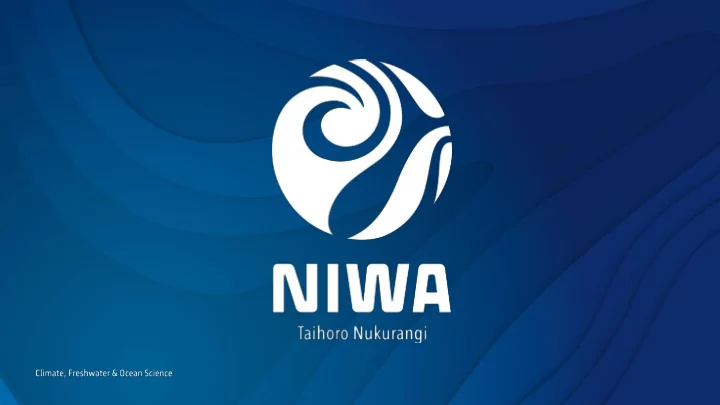

INT2019-05: Coral biodiversity in deep-water fisheries bycatch Jaret P. Bilewitch – jaret.bilewitch@niwa.co.nz Di M. Tracey
Protected corals Diverse and distantly related assemblage of marine animals Cl. Hydrozoa Fam. Stylasteridae (Hydrocorals) Phylum O. Alcyonacea (gorgonian corals) S.C. Octocorallia “gorgonians” “octocorals” Cnidaria Cl. Anthozoa O. Zoantharia (gold corals) “sea fans” “sea whips” S.C Hexacorallia O. Scleractinia (stony/hard corals) “bubblegum corals” “gold corals” O. Antipatharia (black corals)
O. Alcyonacea (= O. Gorgonacea) • Ancient – over 500my • Over 3000 species worldwide • Found in all oceans, nearly all depths • ‘Gorgonians’ = VME Indicator Taxa From Tracey & Hjorvarsdottir 2019 4
O. Alcyonacea • In NZ, >250 species (most undescribed) From Tracey & Hjorvarsdottir 2019 • Widely distributed across all FMAs • All gorgonian octocorals are protected (Wildlife Act) 5
Protected gorgonian octocorals • Extremely diverse in appearance 6
Protected gorgonian octocorals • Common amongst coral bycatch 7
Protected gorgonian octocorals • Coral bycatch from trawl fisheries (ORH, OEO, LIN, etc.) 8
Protected gorgonian octocorals • Impacts on diversity? → observer images (but up to 50% error in IDs) Tracey et al. 2011: From Tracey et al. 2019 9
Protected gorgonian octocorals • Impacts on diversity? → observer images → observer sampling → Expert morphological IDs → Genetic IDs 10
Study goal • Use genetic analysis (DNA barcoding) of collected bycatch specimens in NIWA Invertebrate Collection to examine coral species diversity • Is morphological study providing accurate diversity/identity info? • How much bycatch diversity exists among trawl bycatch? • Given sampling breadth, can it tell us something about gorgonian diversity in general? 11
Study design • NIWA Invertebrate Collection: 1190 octocoral bycatch specimens • Approx. 700 in ethanol • 129 identified as suitable for this study - specimen <10 yrs old, protected status - from within EEZ (some neighboring SPRFMO samples) - bottom-trawl bycatch (few bottom long-line specimens) 12
Study design • Explored two three genetic markers for barcoding: - 5’ -mtMutS – ‘universal’ octocoral barcode (families/genera) (lots of pre-existing data but low-res) - 3’ -mtMutS – bespoke barcode (genera/some species) (little pre-existing data but reliable & high-res) - 28S rDNA – ‘universal’ species -level barcode (high-res but too variable; heterozygosity; multicopy gene) 13
Results Protected Families # Sequenced • Sampled 91 bycatch specimens Acanthogorgiidae 3 (+1) • +8 pre-existing sequences Chrysogorgiidae 8 • +16 ‘reference’ specimens Coralliidae (+3) Isididae 15 → Sequence data for 75 specimens Paragorgiidae 9 (+1) → Trawl bycatch from 6 families Plexauridae 7 (+7) Primnoidae 9 (+4) 14
Rate of new species discovery • Many left to be discovered ORH 45 40 25 35 20 30 Cumulative novel taxa 25 # Genotypes 15 20 10 15 10 5 5 0 0 0 5 10 15 20 25 30 0 10 20 30 40 50 60 70 80 # Trawls per target fishery Cumulative specimens sequenced 15
Phylogenetics crash course Species 3 no scale Species 1 -represents when species diverged Species 2 genetic distance ≈ time 16
Results: Paragorgiidae 541-1228m depth 17
Results: Chrysogorgiidae 437-1200m depth 18
Results: Primnoidae 447-1100m depth 19
Results: Isididae 431-1208m depth 20
Results: Plexauridae + Acanthogorgiidae 137-1182m depth 21
Identification Accuracy & Precision • Are IDs the same? • Are IDs the same, to the same level? Strict Relaxed Observer Morpho-taxonomy Phylogenetics Observer - 19% (12/64) 33% (15/45) Precision Morpho-taxonomy 11% (7/64) - 21% (16/76) Accuracy Phylogenetics 22% (10/45) 8% (6/76) - 22
Bottom-Trawl Fisheries Interactions Row Labels BOE BYS BYX HOK HPB LIN ORH SSO TAR WWA Total Acanthogorgiidae - - - - - 1/1 2/3 - 1/1 - 2/5 Chrysogorgiidae - 1/1 - 2/2 - - 4/5 - - - 7/8 Isididae 1/2 1/1 - - - - 7/16 3/3 - 1/1 10/23 Paragorgiidae 1/2 - 1/1 - - - 3/4 2/2 - - 4/9 Plexauridae - - 1/1 - 1/1 - 4/4 1/1 - - 5/7 Primnoidae - 1/2 - 1/1 - - 4/5 1/2 - - 5/10 Total Species/Samples 2/4 3/4 2/2 3/3 1/1 1/1 23/37 7/8 1/1 1/1 32/62 # Trawls 4 4 2 3 1 1 29 8 1 1 54 25 20 # Genotypes 15 10 5 0 0 5 10 15 20 25 30 # Trawls per target fishery ORH 23
Fisheries Interactions - Impacts • Not just about the numbers • E.g. : 3 species from one tow… Vessel #3 Vessel #1 Vessel #2 24
Fisheries Interactions - Impacts • Not just about the numbers • E.g. : 3 species from one tow… 100s-1000s years 10-100 million years 100-250 million years 25
Fisheries Interactions & Biodiversity • Not just about the numbers • Genetic diversity (species diversity) carries implicit evolutionary component biomass, prevalence, productivity, genetic distinctiveness → fisheries impacts/intrinsic value of biodiversity 26
Study goals • Is morphological study providing accurate diversity/identity info? Not t alw lways, but t it it does s rela late sp specim imens to desc scrib ibed sp specie ies • How much bycatch diversity exists among trawl bycatch? More th than we know • Given sampling breadth of observer collection, can it tell us something about gorgonian diversity in general? We have a lot lot of f NZ Z div iversit ity le left ft to disc iscover & desc scrib ibe - obse serv rver r sa sample les can pla lay a vit vital l role le 27
Recommendations • Encourage increased Observer coral bycatch sampling • Examine bycatch (genetic) diversity in more target fisheries or gear (OEO; long-line) • (again) Routine DNA barcoding for protected coral bycatch can improve our knowledge of fisheries impacts and NZ biodiversity e.g. can incorporate genetic diversity into habitat suitability models 28
Acknowledgements • Fisheries Observers Amalia Calle (NIWA Intern) • Sadie Mills & Diana Macpherson Di Tracey (NIWA) (NIWA Invertebrate Collection) • Jade Maggs & Aiden Liu Funded by DOC – CSP (NIWA Fisheries Data Service) • Chris Dick & RDM team (MPI-FNZ) • Lyndsey Holland (MPI-FNZ) 29
Jaret Bilewitch Molecular Biologist Environmental Isotopes & Molecular Biology 04 386 0502 jaret.bilewitch@niwa.co.nz
Recommend
More recommend